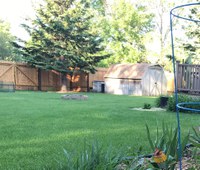Dakota Gardener: Mixing Up the Lawn
(Click an image below to view a high-resolution image that can be downloaded)
By Carrie Knutson, NDSU Extension Agent, Grand Forks County
If you are thinking about doing something different with your lawn space, you are not alone.
Lawn trends are moving toward environmentally conscious practices that balance green space with plant diversity for wildlife and pollinators.
Renovating areas of your lawn might be an option for you if your yard has areas that receive very little foot traffic or areas where getting grass to grow is difficult because of poor soil or too much shade, or if you want to add more plant diversity.
You have several different choices for mixing up your lawn, depending on your needs.
Groundcover plants are low-growing plants that, once established in the landscape, can reduce landscape maintenance, and prevent soil erosion and weeds. Groundcovers can be woody plants such as creeping juniper or herbaceous perennials that spread via creeping roots.
If you struggle to grow grass or other plants underneath the heavy shade of trees, use mulch. The mulch will prevent weed growth, conserve water and prevent your lawn mower and trimmer from getting too close to the trees.
Use garden beds or borders to increase plant diversity. Native gardens, pollinator gardens or edible landscapes can be created to benefit you and the environment. Start small and use mulch to help control weeds and conserve moisture. Time spent maintaining gardens will be similar to the time spent maintaining your lawn.
For large areas of land, a meadow can be created in areas that receive at least six hours of sunlight a day. Meadows are mostly native grasses with some flowering native perennial plants. However, meadows can be expensive and time consuming to establish.
Incorporating grasses that require less mowing and care into the existing turf is an option. For sunny areas that are not watered or fertilized and mowed not more than once a week, consider using a mix of half common type Kentucky bluegrass and half fine fescue.
In partially shady areas, the mix would be 80% to 100% fescue, with the remainder being Kentucky bluegrass. Fine fescues can be mowed less often, and they tolerate poor soil and dry conditions, but they do not tolerate foot traffic as well as Kentucky bluegrass.
I am slowly starting to incorporate some of these options into my own lawn. I use mulch under my trees, and I am establishing pollinator gardens. I have saved myself some time and I still have plenty of space for my kids to play and my dog to dig.
Happy gardening!
For more information about gardening, contact your local NDSU Extension agent. Find the Extension office for your county at https://www.ag.ndsu.edu/extension/directory/counties.
NDSU Agriculture Communication - May 18, 2021
Source: Carrie Knutson, 701-780-8229, carrie.knutson@ndsu.edu
Editor: Ellen Crawford, 701-231-5391, ellen.crawford@ndsu.edu




